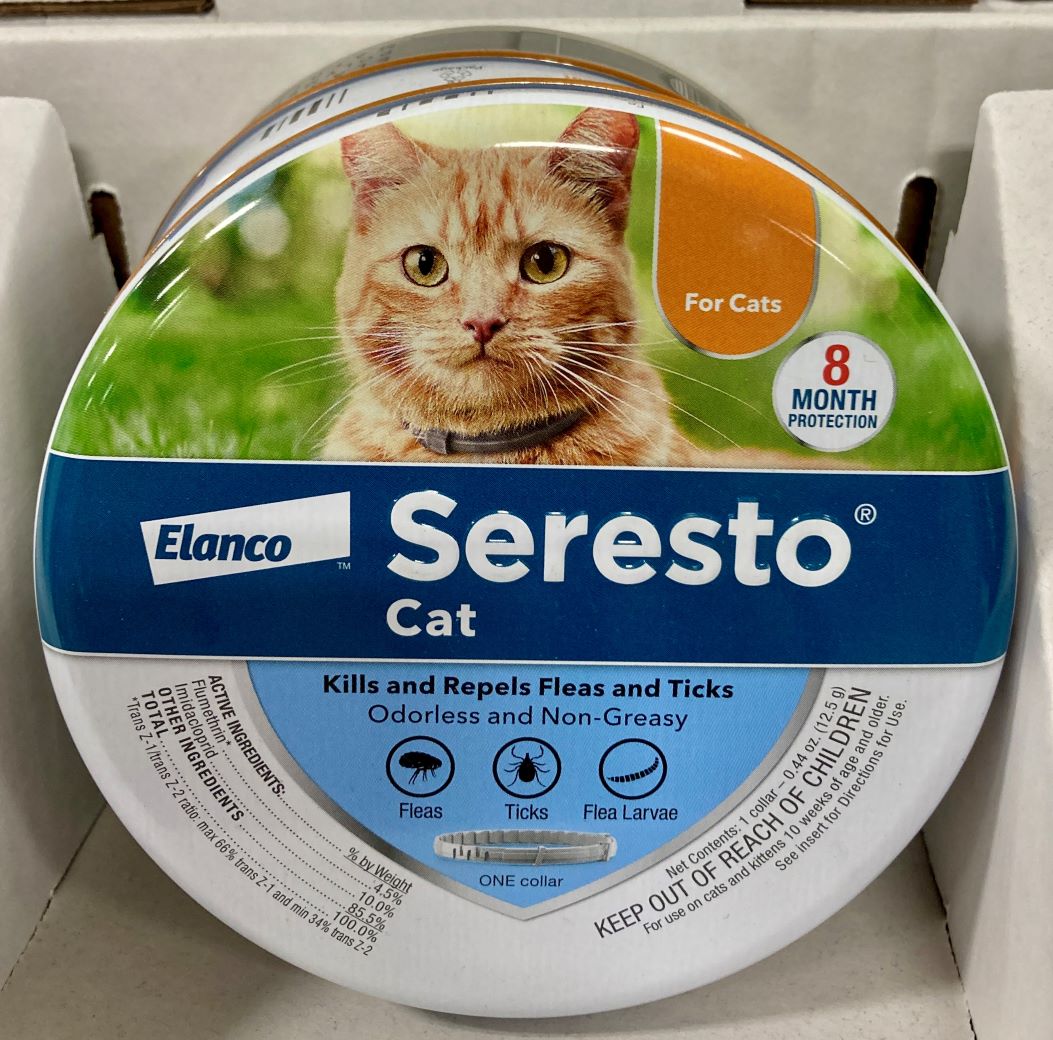Seresto cat collar

VIN News Service photo
Potentially closing a safety debate that dates to 2021, the U.S. Environmental Protection Agency announced last week that Seresto flea and tick collars for cats and dogs may remain on the market, provided the manufacturer takes extra steps to lessen the risk of adverse incidents.
 Listen to this story.
Listen to this story.
Seresto flea collars can continue to be sold in the United States, the Environmental Protection Agency has announced, rebuffing calls by lawmakers, activists and pet owners to pull them from the market due to safety concerns.
The decision, published Wednesday, comes with several mitigation requirements for manufacturer Elanco Animal Health, including improving how it reports adverse incidents, adding new warnings to product labels and expanding outreach to veterinarians.
The collars were developed by Bayer Animal Health, which Elanco bought in 2020. Elanco said 41 million collars have been sold in the U.S. since 2013.
A 2021 USA Today article raised anxieties about possible health impacts of the collars, which release a small amount of the insecticides flumethrin and imidacloprid onto the animal's fur over months. The story linked Seresto collars to the deaths of hundreds of dogs and cats, and hair loss, skin rashes, lethargy, lack of appetite or seizures in tens of thousands more pets, based on adverse incident reports submitted by pet owners, veterinarians and other interested parties to the EPA.
That story triggered a petition calling on the EPA, which regulates topically administered pet pesticide products, to withdraw approval for the sale of the collars (known as registration). It also led to a class-action lawsuit against Elanco claiming that pets were harmed by the product, and a congressional subcommittee hearing during which some lawmakers called for the EPA to cancel the collar's registration.
In response, the EPA initiated a comprehensive review of 75,000 adverse incident reports filed between 2012, when the agency first approved the collar, and 2020. Last week's decision was based on that review.
The EPA's Memorandum in Support of the Regulatory Decision presents a mixed picture. It portrays Seresto as a safe and effective flea control product but one that needs more robust oversight, reporting and disclosure of possible risks. The registration is time-limited to five years. Elanco must apply for continued use at least a year before the expiration date. Typically, pesticides have a 15-year registration with the EPA.
The Center for Biological Diversity, a nonprofit conservation organization that has been leading calls for Seresto to be pulled from the market, responded to the EPA decision with a press release emphasizing that Elanco would now have to place warning labels on the packaging and must do more "robust reporting" of harm incidents.
"We're disappointed the EPA didn't cancel Seresto collars, but it's heartening that they're alerting pet owners to the troubling risks linked to the product," Nathan Donley, the center's environmental health science director, said in the release.
In its own press release, Elanco emphasized that the collars could continue to be sold, saying the "comprehensive, multi-year review by the EPA ... confirms Seresto continues to meet EPA standards for product registration; data affirms the safety profile of the product."
Veterinarians were puzzled by collar concerns
When the USA Today story broke, some veterinarians fielded calls from worried pet owners. Many doctors expressed surprise about the concerns. Two veterinary toxicologists who spoke to the VIN News Service said that consumer reports, as described in the article, didn't present a consistent or coherent picture of heightened risk for a collar that is effective at protecting pets against fleas and ticks, exposure to which poses poses health risks of their own.
A poll in June 2022 to which nearly 2,500 members of the Veterinary Information Network, an online community for the profession, responded found that among veterinarians with patients using Seresto collars, the majority saw no adverse reactions. Of those who did see reactions, mild skin pathology was by far the most common. One respondent reported a death associated with the collar.
The American Veterinary Medical Association has opposed canceling Seresto's registration.
Details from the review
Gut-wrenching stories of pets purportedly killed by Seresto collars have helped drive public outrage and worry about the products. However, in its analysis of more than 1,400 deaths reported to the agency from 2016 to 2020, the EPA could not determine the cause of death in the majority of cases, due to a lack of critical details about the incidents.
In cases where sufficient details were provided, the EPA couldn't say with "high confidence" that the collar caused the death, often because of confounding factors such as concurrent medical conditions. In addition, the rate of deaths reported was similar between Seresto and other available pet products.
"All the reported death cases that were found to be probably or definitely related to the Seresto product use (4 canine and 9 feline out of 1477 cases reviewed) were associated with mechanical strangulation or trauma caused by the collar, often associated with a failure of the release mechanism," the memorandum said.
To reduce the risk of strangulation, the EPA directed Elanco to evaluate potential changes to the emergency release mechanism and report back to the agency. Following that analysis, the EPA may require a modified release mechanism for the collar.
The most commonly reported clinical signs in dogs were itchy skin (54% of cases), lethargy (10%) and anorexia (10%). In cats, the most frequently reported sign was hair change at the application site (32% of cases), followed by site lesions (25%) and itchy skin (25%).
More severe clinical signs — convulsions, for example — were reported much less frequently.
Suggesting cause and effect, the EPA said that "the removal of the collar often seemed to alleviate symptoms, and/or reapplication of the collar coincided with a reoccurrence of symptoms."
Based on the findings, Elanco also agreed to:
- include warnings on Seresto products that describe commonly reported adverse effects, along with instructions to remove the collar if those effects occur and how to report the incident;
- develop an outreach program to communicate with veterinarians and the public the risks and benefits of using the product;
- ensure that complete details are collected for incidents reported by consumers, including whether the pet had any preexisting conditions.
Throughout the review process, EPA consulted with the U.S. Food and Drug Administration, which also regulates pet parasiticides, including products that are given orally. This agencies' collaboration could lead to a transformation in how flea collars are regulated.
In February, the agencies proposed that the FDA take over the responsibility for regulating topically administered pet pesticide products.
Update: On Jan. 6, 2025, U.S. District Court Judge John Robert Blakey approved a $15 million settlement in the class action suit against Elanco and Bayer. The settlement resolves claims that the companies did not properly warn customers of risks related to Seresto collars. The companies have admitted no wrongdoing. The settlement will be used for cash payments to qualified class members, including $13 per collar. For "alleged non-fatal pet injuries," the settlement fund provides reimbursement of $25 or 100% of any out-of-pocket costs. “Alleged pet deaths” will be compensated at $300, plus 100% of any out-of-pocket costs for medical treatment and/or death-related costs.